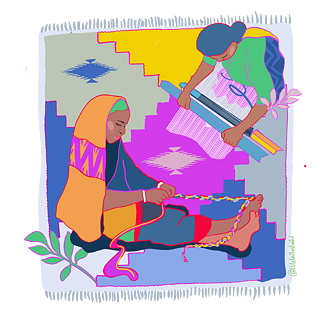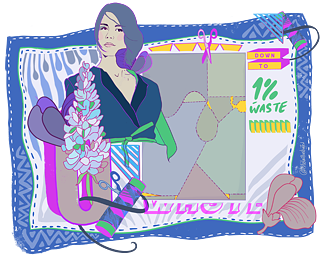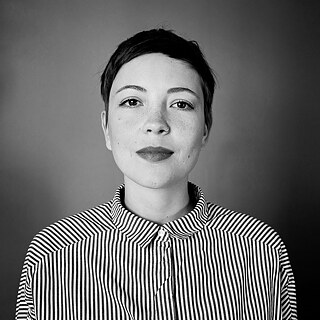Rethinking Fashion

Rethinking fashion: a German-Bangladeshi exchange programme is in search of solutions for a sustainable textile industry
By Anna Kessel
“Fashion students from Germany know Bangladesh, currently one of the most important international production countries for textiles, mostly by hearsay. Aspiring fashion designers in Bangladesh will work for markets in the United States, Asia and Europe in their future working lives, but during their studies they will only be offered very limited information on current international fashion events,” states Prof. Heike Selmer, co-founder and project manager of LOCAL INTERNATIONAL, fashion designer, professor for fashion design at the weißensee kunsthochschule berlin and founder of greenlab, the laboratory for sustainable design strategies. In the exchange programme “LOCAL INTERNATIONAL IV – social design and crafts” students from Berlin and Dhaka meet with internationally active designers and producers to find their own answers for the most urgent topics in the textile industry. Focus of the first module: social, ecological and cultural sustainability.
Growing awareness of a dirty industry
The fashion and textile industry trades in beauty, but has its dark sides. The high use of fertilizers and pesticides as well as the consumption of water in the cultivation and production of cotton, the chemicals used in textile manufacturing processes and last but not least the enormous production quantities make the industry one of the largest polluters worldwide. The reality of the production conditions is also dirty. The label "Made in Bangladesh" can be found on clothing worldwide and stands for the successful international rise of a nation to the number one production country, but also for extreme low wages, critical working conditions and the loss of local knowledge about traditional textile crafts.However, tragedies such as the collapse of the Rana Plaza factory in Bangladesh in 2013 and climate change are also contributing to the increasing search for solutions. Awareness of sustainability is growing - both among consumers and when it comes to setting the tone in design and production. Two areas of the textile industry come into particular focus and are an integral part of the discussions in the exchange between the students from Berlin and Dhaka in the summer of 2020: global supply chains and textile value chains.

Rethinking supply chains
Arianna Nicoletti and Ariane Piper, both part of the educational project Green Fashion Tours explain vividly what problems the paradigm shift to so-called fast fashion – cheap mass-produced goods – has created in the past 15 years. By outsourcing many production steps to countries in the low-wage sector, the supply chains are confusing and difficult to understand, even for contracting textile companies. At the end there is often a lack of union freedom, gender inequality and low working wages – while at the beginning of the chain we miss a legal basis to hold companies liable for what happens in their supply chains. The topic of wage policy in particular is as complex as it is important, explains Ariane Piper. It is essential to make a distinction in the discussion between minimum and living wages. It is not enough that large international corporations can demonstrate minimum wages at their production partners in their Transparency Reports – for which Bangladesh is a good example. It wasn't until 2019 that minimum wages in Bangladesh were raised to a monthly wage of $95. Renowned international organizations like the Clean Clothes Campaign and Piper claim that this is still too low. A reasonable living wage should be around $ 260 to cover the cost of a decent human life. And: According to Piper, the retail prices for a T-shirt would only increase by a small amount if wages were fair. Her plea: “Companies and big brands absolutely have to rethink their pricing policies.” And that is also important to her: “We are currently facing too many voluntary solutions. What we need in the end are international laws and binding regulations for industry!”While real political solutions are a long way off, Piper has advice for the prospective designers:
If we get the chance to reshape production processes and think them accordingly, we must definitely involve stakeholders!
According to the stakeholder approach, a company should know each and every one of its interest groups and consider their needs – profitable for all those involved. For designers like Natascha von Hirschhausen, herself a former participant at LOCAL INTERNATIONAL and winner of the German federal ecodesign award, this means entering into partnerships on eye level and based on mutual trust. When founding her label, the Berlin based designer chose to produce locally in her own studio, with zero waste designs and only on request. The issue of supply chains and ecological and social sustainability therefore primarily concerns the sourcing of fabrics and materials – leading to collaborations with, amongst others, Living Blue from Bangladesh, which she got to know on her trip with LOCAL INTERNATIONAL to Bangladesh in 2015. The social enterprise, which is run by the craftsmen themselves, has dedicated itself to the restoration of cultural textile techniques, paying particular attention to the Bengal crop Indigo and its cultivation and processing. Murtaza Jahangir from Living Blue, who is among the guests at LOCAL INTERNATIONAL explains the economic premise behind Living Blue: The organization, under which today over 3,000 indigo farmers are organized in family-run farms, not only guarantees a fair wage policy but also contributes to the creation of sustainable social, cultural and economic life. The fact that the products are so well received on the market is a win-win situation for designers who are looking for sustainable solutions and the farmers of Living Blue alike. “As a fashion designer,” Arianna Nicoletti emphasizes as well “we have an enormous responsibility to help shape and, above all, redesign supply chains. To do this, we need a holistic understanding of the industry and we need to know every step a garment goes through.”

Creating circular value chains
The issue of a circular economy is particularly important to Nicoletti, a former participant in the residency on circular fashion advertised by the Goethe Institut UK and the V&A Museum of art, design & performance. Not only the working conditions along the supply chains, but also ecological sustainability in production is a problematic and urgent issue that needs solving. In recent years, as the entrepreneurs invited to LOCAL INTERNATIONAL like Natascha von Hirschhausen have shown, a lot of research has been conducted in search of new materials and more sustainable and resource-saving production methods. But if we look at the mass of textiles produced annually, it is clear to Nicoletti that we need solutions on a larger scale. Nicoletti's perspective:
We have to get away from the linear way we produce and consume today, which produces far too much waste and does not recognize it as a valuable resource.
Already in the manufacturing processes, she explains, there is an unbelievable amount of textile waste. This adds up with the deadstock resulting from overproduction and the post-consumer waste, meaning the garments that flood the second hand market. Circular value chains could help by recycling materials directly back into the design phases. Here it is important to develop interdisciplinary solutions between designers and producers.
How can that be applied? Simone Simonato, founder of the company SICA up-cycling, is committed to such circular thinking, especially when it comes to sourcing and design. During her master’s degree, the designer began to collaborate with a company in Bangladesh. With SICA Clipping Up, Simonato is now successfully transferring textile waste from the clothing industry in Bangladesh to artisanal businesses in rural Rangpur in northern Bangladesh in order to further develop local weaving techniques with the craftsmen and to create new products from textile waste.

Using local knowledge – an outlook
With the integration of local weaving into her concern to find sustainable solutions for the textile industry, Simonato has met with great interest among the prospective designers from Berlin and Dhaka. The topic of local knowledge is not only interesting because industrialized textile production has led to a gradual loss of handicraft techniques in both Germany and Bangladesh. Above all, there is great hope of developing a socially, economically and ecologically sustainable production that adapts to the needs of its surroundings. Of course, this is not limited to crafts, but includes such complex topics as raw materials, material development and reprocessing.Tau Pibernat, one of the participants at LOCAL INTERNATIONAL and a former participant in the greenlab, Labor für nachhaltige Designstrategien at weißensee kunsthochschule berlin, is therefore looking forward to the ourse of the exchange programme:
“I completed every possible sustainability training at my university and took part in greenlab twice. From this interest a project evolved, throwing light on the nettle as a wild growing, sustainable resource for textiles. As the historical knowledge of how to use nettle as a sustainable fibre has been lost its relevance it was almost archaeological research. I’m really interested in what kind of textile knowledge has been lost, but maybe bears actual solutions for today – as well as in phenomena like urban mining, and the current trend for looking which resources are already circulating in our system and could be used again.” – Tau Pibernat, participant at LOCAL INTERNATIONAL.
About the AUTHOR

ABOUT THE ILLUSTRATOR
